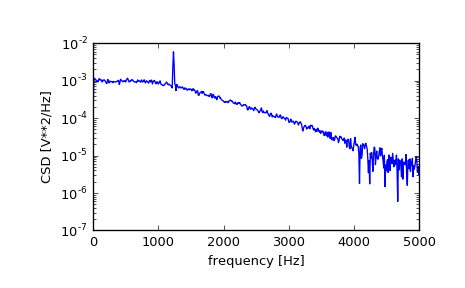scipy.signal.csd¶
-
scipy.signal.csd(x, y, fs=1.0, window='hann', nperseg=None, noverlap=None, nfft=None, detrend='constant', return_onesided=True, scaling='density', axis=-1)[source]¶ Estimate the cross power spectral density, Pxy, using Welch’s method.
Parameters: x : array_like
Time series of measurement values
y : array_like
Time series of measurement values
fs : float, optional
Sampling frequency of the x and y time series. Defaults to 1.0.
window : str or tuple or array_like, optional
Desired window to use. See
get_windowfor a list of windows and required parameters. If window is array_like it will be used directly as the window and its length must be nperseg. Defaults to a Hann window.nperseg : int, optional
Length of each segment. Defaults to None, but if window is str or tuple, is set to 256, and if window is array_like, is set to the length of the window.
noverlap: int, optional
Number of points to overlap between segments. If None,
noverlap = nperseg // 2. Defaults to None.nfft : int, optional
Length of the FFT used, if a zero padded FFT is desired. If None, the FFT length is nperseg. Defaults to None.
detrend : str or function or False, optional
return_onesided : bool, optional
If True, return a one-sided spectrum for real data. If False return a two-sided spectrum. Note that for complex data, a two-sided spectrum is always returned.
scaling : { ‘density’, ‘spectrum’ }, optional
Selects between computing the cross spectral density (‘density’) where Pxy has units of V**2/Hz and computing the cross spectrum (‘spectrum’) where Pxy has units of V**2, if x and y are measured in V and fs is measured in Hz. Defaults to ‘density’
axis : int, optional
Axis along which the CSD is computed for both inputs; the default is over the last axis (i.e.
axis=-1).Returns: f : ndarray
Array of sample frequencies.
Pxy : ndarray
Cross spectral density or cross power spectrum of x,y.
See also
periodogram- Simple, optionally modified periodogram
lombscargle- Lomb-Scargle periodogram for unevenly sampled data
welch- Power spectral density by Welch’s method. [Equivalent to csd(x,x)]
coherence- Magnitude squared coherence by Welch’s method.
Notes
By convention, Pxy is computed with the conjugate FFT of X multiplied by the FFT of Y.
If the input series differ in length, the shorter series will be zero-padded to match.
An appropriate amount of overlap will depend on the choice of window and on your requirements. For the default ‘hann’ window an overlap of 50% is a reasonable trade off between accurately estimating the signal power, while not over counting any of the data. Narrower windows may require a larger overlap.
New in version 0.16.0.
References
[R213] P. Welch, “The use of the fast Fourier transform for the estimation of power spectra: A method based on time averaging over short, modified periodograms”, IEEE Trans. Audio Electroacoust. vol. 15, pp. 70-73, 1967. [R214] Rabiner, Lawrence R., and B. Gold. “Theory and Application of Digital Signal Processing” Prentice-Hall, pp. 414-419, 1975 Examples
>>> from scipy import signal >>> import matplotlib.pyplot as plt
Generate two test signals with some common features.
>>> fs = 10e3 >>> N = 1e5 >>> amp = 20 >>> freq = 1234.0 >>> noise_power = 0.001 * fs / 2 >>> time = np.arange(N) / fs >>> b, a = signal.butter(2, 0.25, 'low') >>> x = np.random.normal(scale=np.sqrt(noise_power), size=time.shape) >>> y = signal.lfilter(b, a, x) >>> x += amp*np.sin(2*np.pi*freq*time) >>> y += np.random.normal(scale=0.1*np.sqrt(noise_power), size=time.shape)
Compute and plot the magnitude of the cross spectral density.
>>> f, Pxy = signal.csd(x, y, fs, nperseg=1024) >>> plt.semilogy(f, np.abs(Pxy)) >>> plt.xlabel('frequency [Hz]') >>> plt.ylabel('CSD [V**2/Hz]') >>> plt.show()

